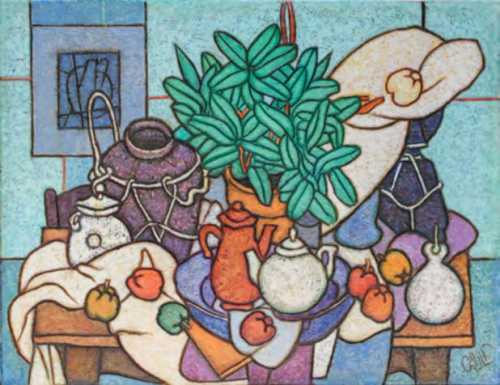About Garnik Der Hacopian
Garnik Der Hacopian is a well known Iranian graphic designer, architect and modernist painter due to his still life paintings. After a period of experimenting with geometric abstraction, Der Hacopian turned to figurative painting. Using motifs inspired by Iranian miniature painting and a special way of performing the work- engraving on a concrete bed, he gave a decorative effect to his painting."
Garnik Der Hacopian began his artistic career while studying at the Academy of Fine Arts and then went on to study painting at the Faculty of Fine Arts in the University of Tehran. In the 1960s Der Hacopian, together with Ruyin Pakbaz, Mansour Ghandriz, Mohammad Reza Judat, Mir Hossein Mousavi and others, established one of the most active and influential private art institutions in Tehran. After joining the group of Ghandriz Hall painters, Garnik followed a new path in his career. His first solo exhibition was held in Seyhoun Gallery in 1975, and two years later, a number of his works were exhibited at the Basel International Exhibition in Switzerland. This artist has also worked in architecture and interior design after the Revolution in 1971.
Hacopian used a variety of techniques in his Still life paintings, including oil painting and cement work, and blended the centuries-old Armenian artistic tradition with European Cubism, eventually acquiring a special visual language. Ruyin Pakbaz writes in this regard: "Garnik underlies various sources such as modern Western art, traditional Iranian art, and Armenian cultural heritage. "Particularly the methods of cubist geometric setting and expressionistic exaggeration of shape and color, as well as old Iranian figurative and Armenian decorative motifs." Some of his still life paintings are the result of hundreds of small and large surfaces lined with decorative motifs.
Garnik Der Hacopian began his artistic career while studying at the Academy of Fine Arts and then went on to study painting at the Faculty of Fine Arts in the University of Tehran. In the 1960s Der Hacopian, together with Ruyin Pakbaz, Mansour Ghandriz, Mohammad Reza Judat, Mir Hossein Mousavi and others, established one of the most active and influential private art institutions in Tehran. After joining the group of Ghandriz Hall painters, Garnik followed a new path in his career. His first solo exhibition was held in Seyhoun Gallery in 1975, and two years later, a number of his works were exhibited at the Basel International Exhibition in Switzerland. This artist has also worked in architecture and interior design after the Revolution in 1971.
Hacopian used a variety of techniques in his Still life paintings, including oil painting and cement work, and blended the centuries-old Armenian artistic tradition with European Cubism, eventually acquiring a special visual language. Ruyin Pakbaz writes in this regard: "Garnik underlies various sources such as modern Western art, traditional Iranian art, and Armenian cultural heritage. "Particularly the methods of cubist geometric setting and expressionistic exaggeration of shape and color, as well as old Iranian figurative and Armenian decorative motifs." Some of his still life paintings are the result of hundreds of small and large surfaces lined with decorative motifs.
The Most Expensive Artwork
At Auctions
First Attendance
7 July 2017
# Attendance
11
# Artworks
11
Average Realized Price
15,033 USD
Average Min Estimate
9,743 USD
Average Max Estimate
13,788 USD
Sell-through Rate
90.909%
Average Growth of Artwork Worth
28.157%
Timeline
The 22nd Tehran - Modern, Classic and Traditional Iranian Art auction
14 February
Modern and Contemporary Collector exhibition
7 February
The 21st Tehran - Contemporary Iranian Art auction
11 October
The 20th Tehran- Modern and Contemporary Iranian Art auction
5 July
Connoisseur's Look exhibition
19 April
10s of Artworks, 10s of Millions exhibition
8 March
Modern Collectore exhibition
19 January
Arthibition auction
20 October
The 17th Tehran Modern and Contemporary Iranian Art auction
18 July
Collector exhibition
15 February
Modern Collector exhibition
24 June
The 15th Tehran- Modern Iranian Art auction
14 January
No.9 auction
3 September
8th Collector exhibition
9 July
Collector 7 exhibition
5 February
The 13th Tehran- Modern and Contemporary Iranian Art auction
15 January
Painting, solo exhibition exhibition
10 January
یازدهمین دوره حراج تهران auction
5 July
The 9th Tehran- Classic and Modern Iranian Art auction
29 June
Artworks Off exhibition
25 August
Shams gallery Collection Special Sale exhibition
7 July
هفتمین دوره حراج تهران auction
7 July
The presence of an absent artist exhibition
11 November
Articles
۱7th Tehran Auction Sales Report 26 July 2023
The 17th Tehran auction: modern and contemporary, was held on Friday July 21st, 2023 at Parsian Azadi Hotel. This auction achieved a total sale of 214 billion tomans equivalent to 4.3 million dollars, which was a growth of 77.8% compared to the previous period. Artchart has observed the 17th Tehran auction in the upcoming report.

